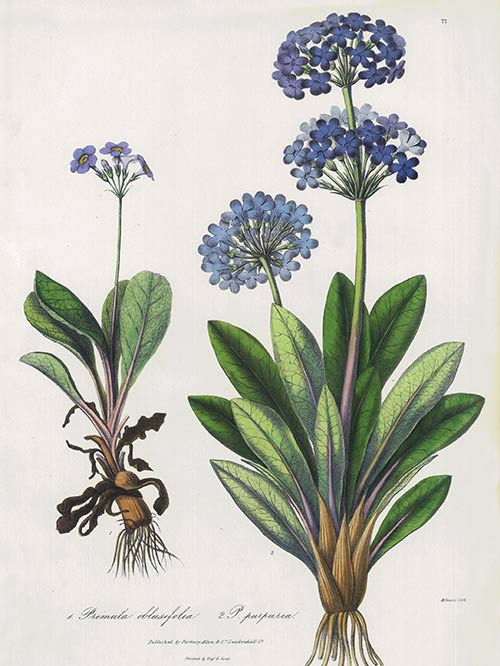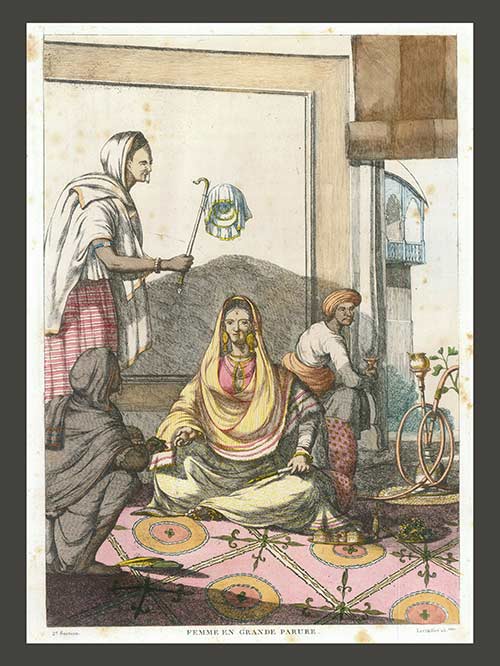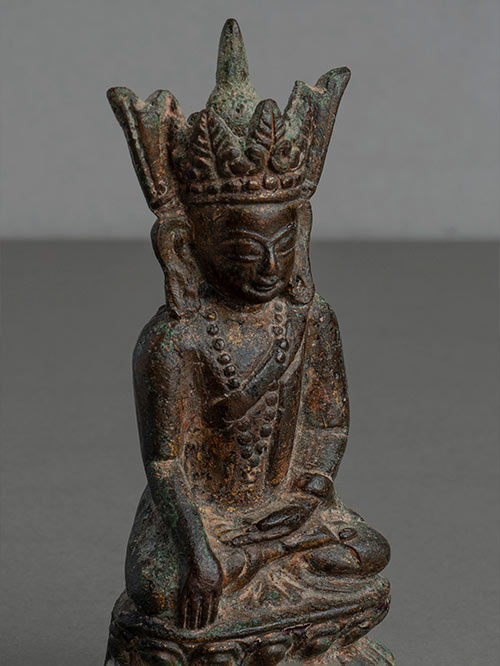“Patanjali” has been added to your cart.
View cart
-


by John Forbes Royle (1798-1858)
Original hand-coloured lithograph
Pub. London
This decorative botanical lithograph depicts two flowering plants, the Primula obtusifolia, commonly known as “Blunt-leaved Primrose,” and the Primula purpurea, commonly known as Purple Himalayan Primrose.” Both are native to the Himalayan region, particularly found in parts of India, Nepal, Bhutan, and Tibet. They grow in alpine meadows and rocky slopes, thriving in cooler, mountainous climates. It is often cultivated as an ornamental plant for its charming flowers and attractive foliage.
John Forbes Royle was a prominent British botanist, physician, and pharmacologist during the 19th century. Royle received his medical education at St. Thomas’s Hospital in London and later served as a surgeon in the British East India Company’s army. During his time in India, Royle became deeply interested in the country’s flora and medicinal plants. He collected a vast number of plant specimens and meticulously documented their medicinal properties. One of Royle’s most notable works was the ‘‘Illustrations of the botany and other branches of the natural history of the Himalayan Mountains and of the flora of Cashmere’. This comprehensive work provided detailed descriptions and illustrations of numerous plant species found in the Himalayan region. It remains an important reference for botanical research in the area.
Image Size (cms): 36.5(H) x 26(W)
Image Size (inches): 14.5(H) x 10(W)
Mount Size (cms): 51(H) x 41(W)
Mount Size (inches): 20(H) x 16(W)
-


by Francois-Balthazar Solvyns (1760-1824)
Original coloured etching
from Les Hindous
Pub. Paris
Solvyns provides a vivid portrayal of a wealthy Hindu woman in full dress, emphasising both the magnificence of her attire and the richness of her surroundings. The woman is seated on a luxurious carpet, with her legs and arms supported by embroidered silk cushions. She is attended by two ayahs (maid servants). One maid offers her paan while another fans her with a hand pankh to refresh the air around her face. In the background, a hookah-bearer prepares the hookah for her to smoke. The lady’s appearance is meticulously described: her hair, made shiny with cocoa oil, is plaited and adorned with pearls or precious stones, with the largest gem positioned in the middle. Solvyns highlights her isolation and idle life, noting that women of her rank live in seclusion, removed from both labor and society, their lives marked by a lack of purpose and contribution, engaging in minimal activities such as playing the tom-tom.
Frans Balthazar Solvyns, was a skilled engraver and painter hailing from Antwerp, embarked on a transformative journey to India in 1790. Settling in Calcutta, Solvyns immersed himself in the intricacies of Indian life, studying Hindi and forging relationships with Brahmins and pundits. Inspired by his surroundings, he commenced his ambitious project in 1791, aiming to depict the diverse facets of Indian society, from occupations to customs which he published in a series of engravings. Despite its sensitive portrayal, the venture encountered little success initially, prompting Solvyns’ departure from India in 1803. However, his legacy endured through subsequent publications, notably “The Costume of Hindoostan” and the expanded edition of “Les Hindous,” offering an intimate and detailed glimpse into 18th-century Indian life across professions, festivals, and daily rituals, immortalising a unique historical moment with both reverence and curiosity.
Image Size (cms): 35(H) x 24(W)
Image Size (inches): 14(H) x 9.5(W)
Mount Size (cms): 51(H) x 41(W)
Mount Size (inches): 20(H) x 16(W)
-


Burma (Myanmar)
Bronze
This charming figure of Buddha depicts him seated in bhumispara mudra (‘calling the earth to witness’). The image wears a sanghati with a long sash that reaches to the waist. The cranial protuberance or usnisha is surrounded by a crown on top of his head.
The posture in which the monks are seated is usually known as the ‘earth-witness’ attitude. This represents the moment when Buddha was seated in meditation under the Bodhi tree during the night before he achieved enlightenment. When he was asked by Mara to name anyone who would give evidence that he had given alms, the Buddha moved his right hand and touched the earth and said that the earth would bear witness that, in a previous existence in the form of Vessantara, he had given alms to such an extent as to cause the earth to quake. Immediately before this incident his right hand was folded in his lap in precisely the same way as his left; here he has moved it in order to touch the earth in front of him in the gesture of calling the earth to witness (bhumisparsha mudra). This is one of the three most popular ways of showing the Buddha in Burmese art; the other two represent him standing and at the moment of his Mahaparinibbana.
Size (cms): 12(H) x 6(W) x 4(D)
Size (inches): 4.5(H) x 2.5(W) x 1.5(D)
-


Tamil Nadu
Wood, extensively polychromed
A fine and rare polychromed and patinated figure of Patanjali. According to legend, Patanjali is the incarnation of the Serpent-God Adisesa, who was moved to become Shiva’s follower after witnessing his cosmic dance. Adisesa wanted to experience the dance, so he was born on Earth with half his body as a snake and was named Patanjali, which means “fallen into folded hands”. When represented in this aspect, Patanjali has the lower body of a snake and his hands are folded in Anjalimudra.
He is most famously known as the compiler of the “Yoga Sutras,” a foundational text on the theory and practice of yoga. The “Yoga Sutras” provide a comprehensive framework for understanding the philosophy and practice of yoga, encompassing principles such as self-discipline (tapas), self-study (svadhyaya), and devotion to the divine (ishvara pranidhana).
Size (cms): 60(H) x 17(W) x 16(D)
Size (inches): 23.5(H) x 6.5(W) x 6.5(D)









